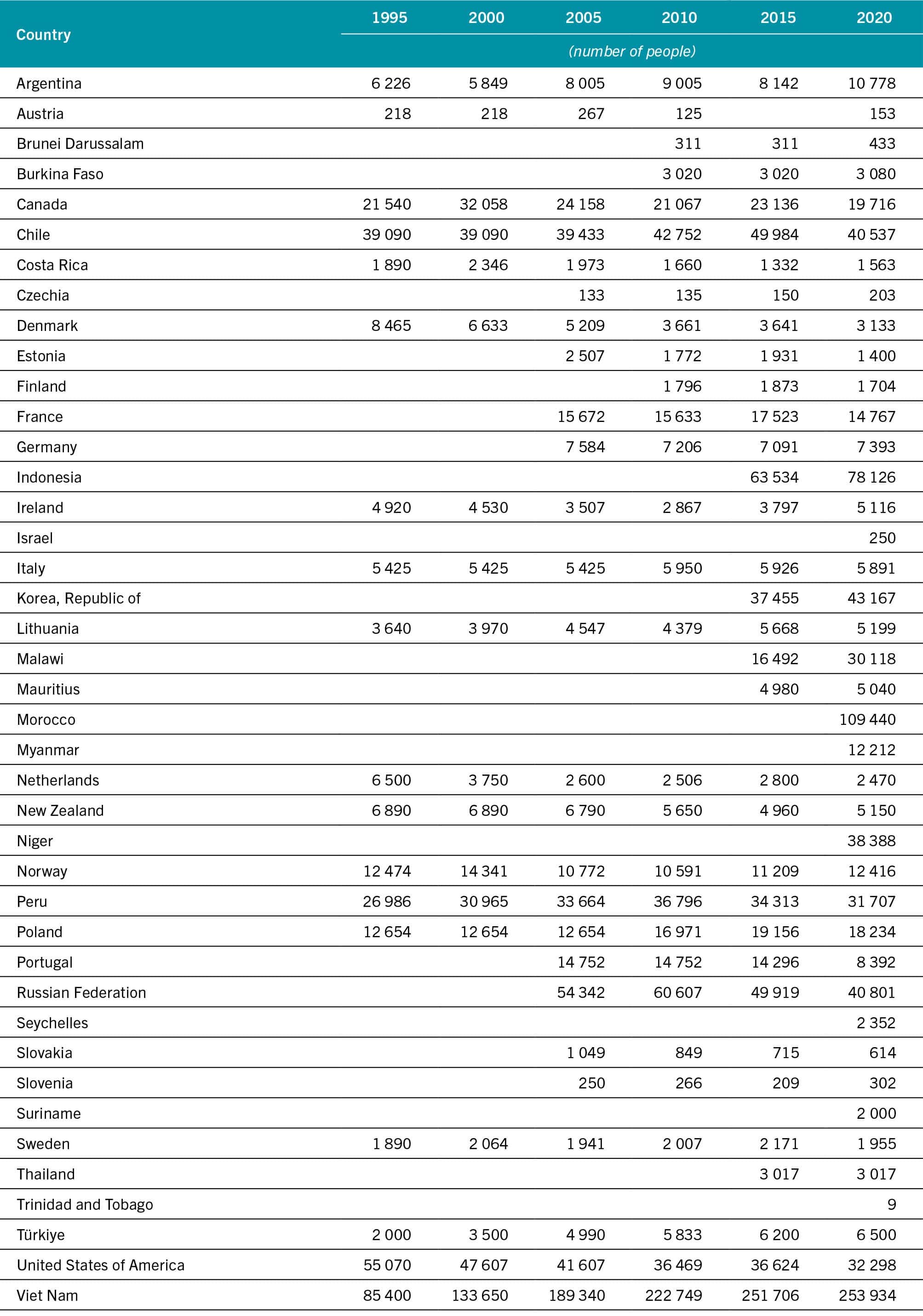This section covers the annual and trend data for employment in fisheries and aquaculture. Most of the dataset regards engagement in the primary sector of fisheries and aquaculture, while a smaller subset also includes data on post-harvest activities, primarily processing.
Employment in the primary sector
In 2020, an estimated 58.5 million were engaged as full-time, part-time, occasional or unspecified workers in fisheries and aquaculture, and of these approximately 21 percent were women. By sector, 35 percent were employed in aquaculture and 65 percent in capture fisheries (Table 12).
TABLE 12WORLD EMPLOYMENT FOR FISHERS AND FISH FARMERS BY REGION FOR SELECTED YEARS, 1995–2020
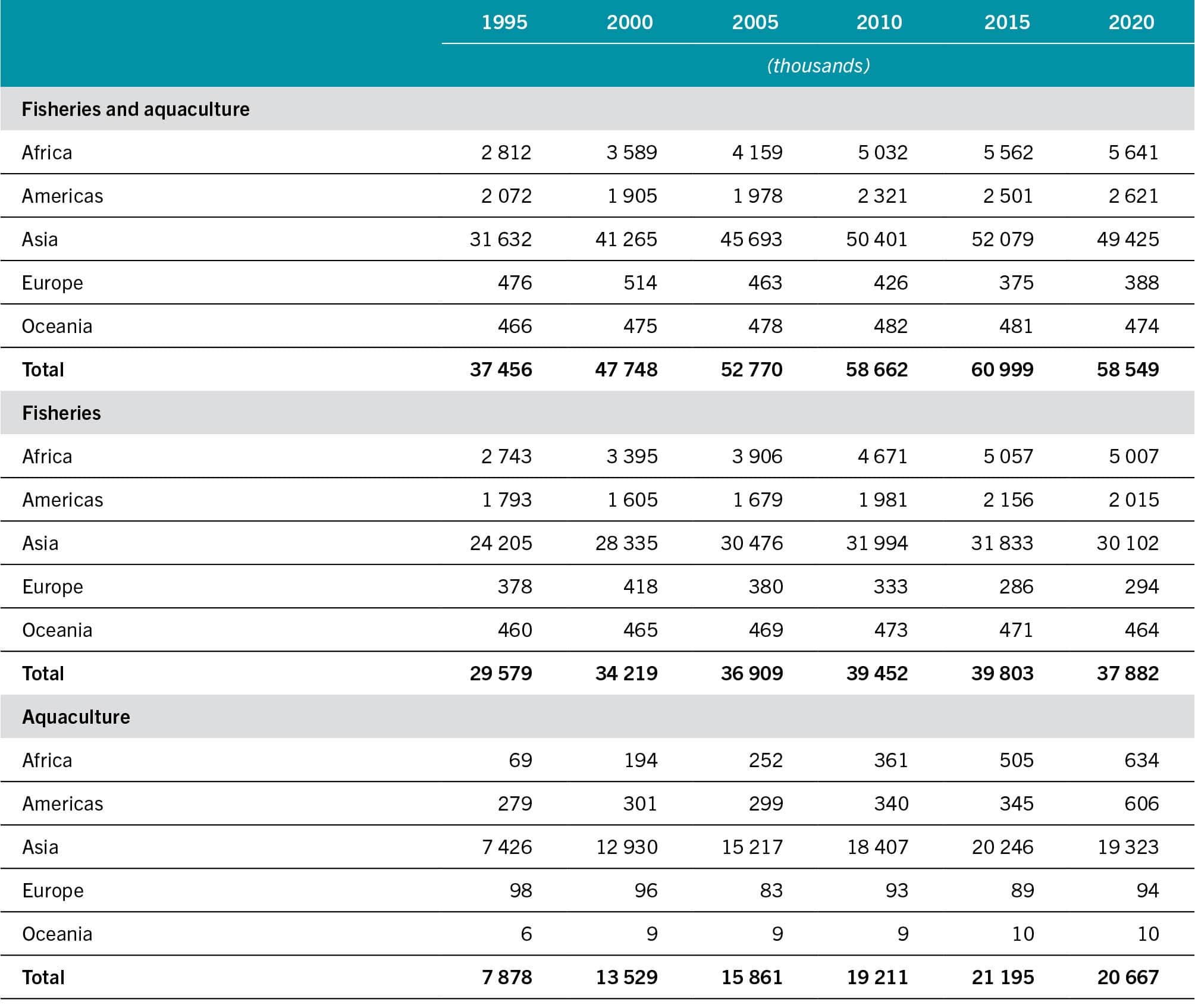
Total employment in the aquaculture sector has been flattening in recent years (Table 12), while the global number of fishers has contracted, particularly driven by trends in Asia. The impact of the COVID-19 pandemic on employment was felt throughout the value chains of fisheries and aquaculture (see the section COVID-19, a crisis like no other). Fishing and aquaculture were disrupted by restrictions on mobility, non-essential activities and trade, causing disruption and shifts in markets and distribution. This varied depending on the country and period of the year, with the virus and its different variants moving from Asia to Europe and the Americas.
In 2020, 84 percent of all fishers and fish farmers were in Asia, followed by Africa (10 percent) and Latin America and the Caribbean (4 percent). More than 20 million were engaged in aquaculture, concentrated primarily in Asia (93.5 percent), followed by Africa (3.1 percent) and Latin America and the Caribbean (nearly 3 percent). Europe, North America and Oceania each had less than 1 percent of the global population engaged as fishers or fish farmers (Figure 32).
FIGURE 32SHARE OF EMPLOYMENT IN THE PRIMARY SECTOR OF FISHERIES AND AQUACULTURE BY CONTINENT
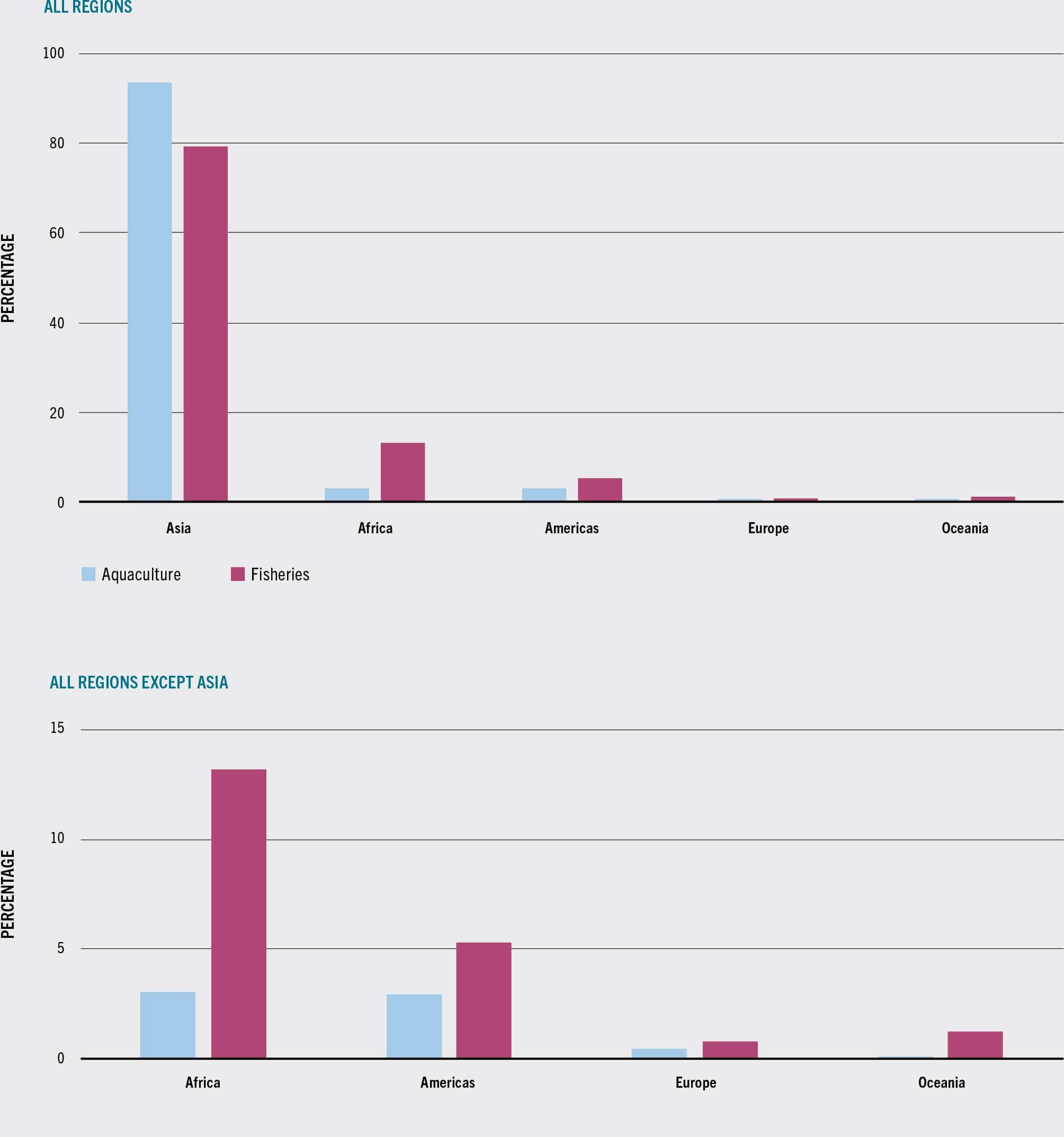
SOURCE: FAO.
Nearly 80 percent of the 37.9 million fishers were from Asia, followed by Africa with 13 percent, the Americas with just over 5 percent (mostly accounted for by Latin America and the Caribbean), Oceania with just over 1 percent and Europe with just below 1 percent.
The trends in the number of people engaged as fishers or fish farmers vary by region. Europe and North America have experienced the largest proportional decreases in the number of both, particularly fishers (Table 12). Africa has experienced steady growth in the employment of fishers and fish farmers, most of which accounted for by fishing. Employment in aquaculture continues to increase in Africa but remains low compared with employment in the African fishing sector. In Asia, engagement in both aquaculture and fisheries is declining for the first time in decades. For fishers, the Chinese fleet reduction (see the section Fishing fleet) and the impact of COVID-19 have been strong drivers of this decline. Fisheries employment decreased 5.4 percent and aquaculture employment decreased 4.6 percent between 2015 and 2020 (Table 12). Oceania also displays a decrease in employment, with the number of fishers dropping while aquaculture workers remained steady between 2015 and 2020. Interestingly, until 2015, employment in Europe was declining in fisheries and aquaculture; however, during 2015–2020 there was 3 percent growth in fisheries and 5 percent growth in aquaculture.
Figure 33 presents employment data disaggregated into full-time, part-time, occasional and status unspecified. Because nearly 40 percent of the employment data are reported as status unspecified, the insights regarding contribution and time dedicated to employment are limited. The proportion of status unspecified is greater for aquaculture, as some of the countries with a high level of employment in aquaculture do not disaggregate data. Approximately 25 percent of employment was reported in the full-time category, 21 percent in part-time and the remaining 14 percent as occasional engagement. Of all female workers, the majority were reported as status unspecified (34 percent), followed by part-time (27 percent). Only 15 percent of the full-time workers were female, further reinforcing research that women tend to have more unstable positions within the value chains of aquaculture and fisheries. However, when considering the available data for the processing sector only, women are found to make up just over 50 percent of full-time employment and 71 percent of part-time engagement (Box 6).
FIGURE 33TIME USE CATEGORIES REPORTING IN THE PRIMARY SECTOR OF FISHERIES AND AQUACULTURE
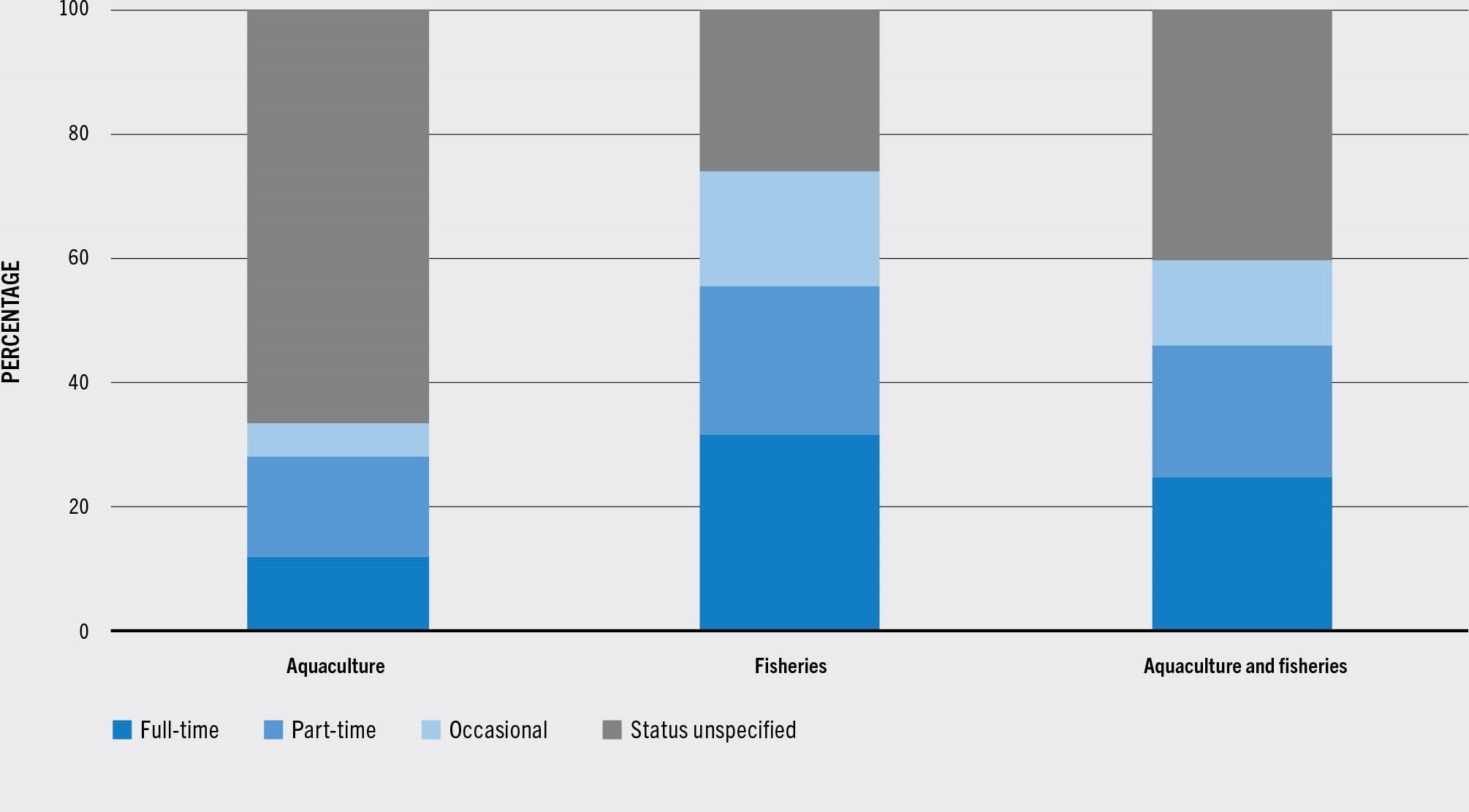
BOX 6RELEVANCE OF SEX-DISAGGREGATED EMPLOYMENT DATA: THE CASE OF THE PROCESSING SECTOR
Processing of aquatic food is at the core of post-harvest activities in the fisheries and aquaculture sector, exerting a direct impact on local to global fisheries and aquaculture economies. Processing encompasses a variety of techniques aimed at the transformation and preservation of fisheries and aquaculture products, ranging from artisanal, small-scale methods to large-scale mechanized operations. In 2012, the World Bank1 estimated that in certain segments of the processing sector worldwide, up to 85 percent of the employees were women. Further, the preliminary results of the recent Illuminating Hidden Harvests study2 show half of the workers in the small-scale fisheries’ post-harvest sector to be women. The high percentages of women engaged in processing can be viewed in light of a socialized space-dependent gendered division of labour in the fishery industry, with men having greater access to the sea and women mainly working on land.3, 4 High female employment in processing also relates to the perception that women are more compliant, flexible and meticulous and accept lower pay than men.5 The latter set of gender norms leads to the poorly paid, unstable and low qualification positions of women in the secondary sector, with little to no recognition provided at the policy level.6
The recent collaboration between FAO and the Organisation for Economic Co-operation and Development (OECD) on a joint study across 49 countries enabled the annual collection of sex-disaggregated data for the fisheries and aquaculture processing sector for those countries. To date, the dataset holds 38 countries’ statistics for employment in the processing sector. Of these, 22 are disaggregated by sex.7 The resulting time series constitutes a promising example for other countries and is being followed by ten additional countries outside the FAO-OECD dataset. FAO encourages the remaining Members to also report their available processing datasets. Yet, data received so far clearly reveal major gaps to fill in national gendered employment statistics. Indeed, the lack of quantitative knowledge on women engaged in post-harvest activities mirrors the issue existing in the primary sector and impedes the achievement of gender equality worldwide, by limiting the adoption of evidence-based policies targeting unequal wages, health risks and gender-based discriminations in the workplace.6 In addition to the reported data from Members, FAO has also conducted a round of work to expand the collection of national, regional and global time series on sex-disaggregated employment data in the processing sector, spanning from 1991 to 2021. The resulting time series are being examined prior to their merging with the reported dataset. The current estimate is that women represent just over 46 percent of the total workforce. Statistics from 117 countries and one regional body have been collected, 58 percent of which present at least one sex-disaggregated value in their time series.
Despite improvement of the latest dataset, processing-specific time series cover only industrial, organized and formal activities. Given the major role of women in artisanal and subsistence fisheries,2 increasing focus should be placed on the collection of sex-disaggregated data in informal, unpaid, subsistence activities. More information on women’s employment status in the post-harvest activities of aggregation and distribution is needed. Finally, the ancillary activities comprising the pre-harvest sector (boat and aquaculture pond maintenance, net mending, bookkeeping, food preparation for fishing trips etc.) are not yet included in the fisheries and aquaculture employment statistics, as they are mostly informal. To recognize the role of the fishery and aquaculture informal sector to support food security and ensure women’s financial empowerment, these activities should be accounted for and the collection of sex-disaggregated data prioritized.
- 1 World Bank. 2012. Hidden harvest: The global contribution of capture fisheries. Economic and Sector Work. Washington, DC. https://openknowledge.worldbank.org/bitstream/handle/10986/11873/664690ESW0P1210120HiddenHarvest0web.pdf?sequence=1&isAllowed=y
- 2 FAO, Duke University & WorldFish. (forthcoming). Illuminating Hidden Harvests: A snapshot of key findings into the contributions of small-scale fisheries to sustainable development. Rome, FAO, Durham, USA, Duke University, and Penang, Malaysia, WorldFish.
- 3 de la Torre-Castro, M., Fröcklin, S., Börjesson, S., Okupnik, J. & Jiddawi, N.S. 2017. Gender analysis for better coastal management – Increasing our understanding of social-ecological seascapes. Marine Policy, 83: 62–74. https://doi.org/10.1016/j.marpol.2017.05.015
- 4 Alonso-Población, E. & Niehof, A. 2019. On the power of a spatial metaphor: Is female to land as male is to sea? Maritime Studies, 18: 249–257. https://doi.org/10.1007/s40152-019-00148-z
- 5 Monfort, M.C. 2015. The role of women in the seafood industry. GLOBEFISH Research Programme, Vol. 119. Rome, FAO. www.fao.org/3/bc014e/bc014e.pdf
- 6 FAO. 2020. The State of World Fisheries and Aquaculture 2020. Sustainability in action. Rome. https://doi.org/10.4060/ca9229en
- 7 See Table 13, p. 74.
Overall, it is estimated that in 2020, women accounted for just over 21 percent of all people directly engaged in the fisheries and aquaculture primary sector – 28 percent in aquaculture and 18 percent in fisheries (Figure 34). This higher proportion than previous estimations is a result of more disaggregated reporting from countries and of FAO’s ongoing effort (since 2019) to improve the quality of the employment data. This work has been conducted for the entire dataset from 1995 onwards and for 49 countries, in collaboration with the Organisation for Economic Co-operation and Development (OECD), harmonizing the employment datasets and streamlining data collection through a joint questionnaire on fisheries and aquaculture employment in the primary and secondary sector to eliminate a double reporting burden for Members.
FIGURE 34SEX-DISAGGREGATED DATA ON EMPLOYMENT IN THE PRIMARY SECTOR OF FISHERIES AND AQUACULTURE BY REGION, 2020
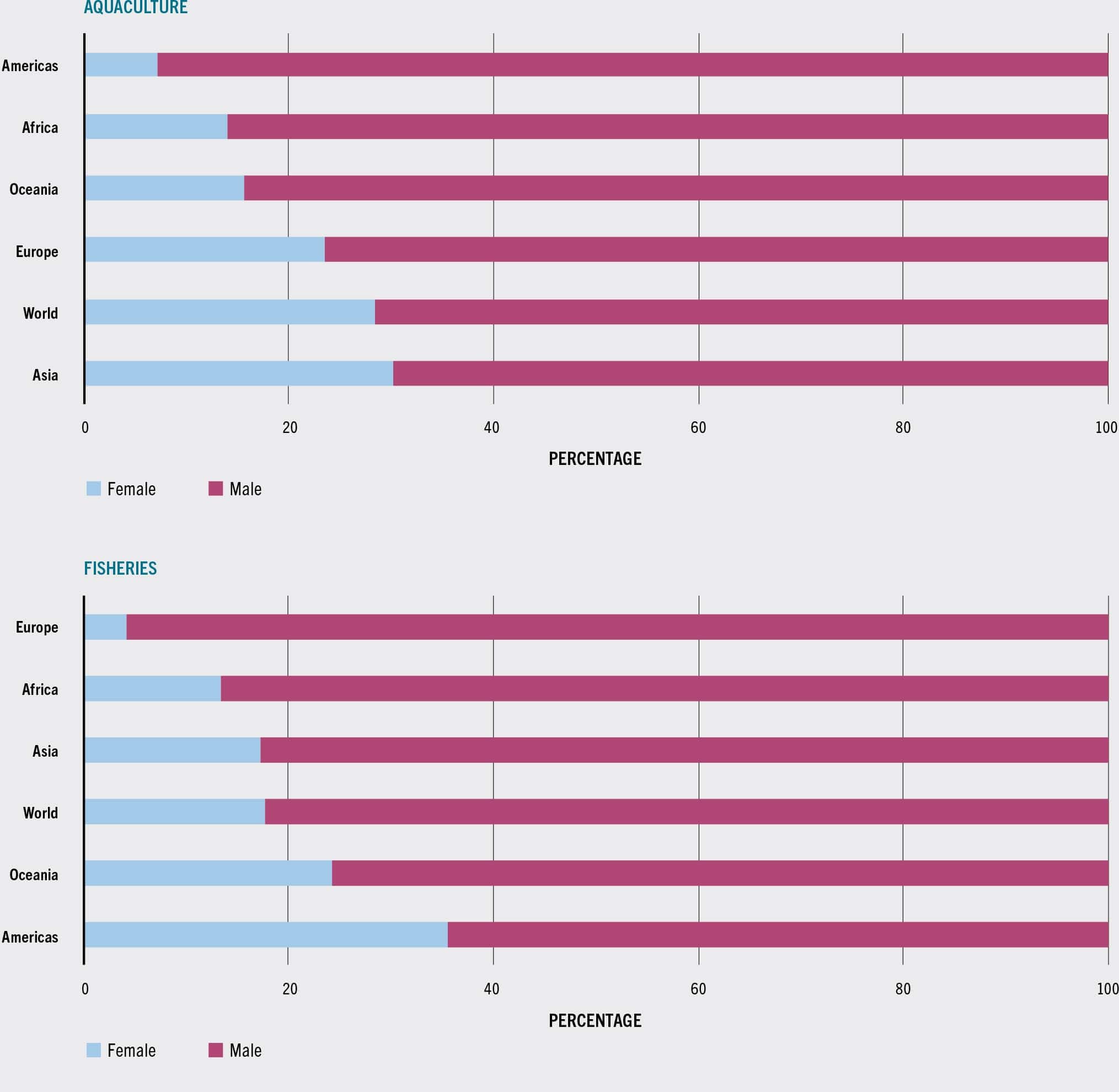
SOURCE: FAO.
Employment in post-harvest sector
Table 13 presents the data reported by selected Member States for employment in the post-harvest sector, particularly in processing. This is explored in further detail in Box 6, as processing is the sector where the largest proportion of women are employed. These figures are complemented by the Illuminating Hidden Harvests study (FAO, Duke University and WorldFish, forthcoming; see also the section Illuminating Hidden Harvests: the contributions of small-scale fisheries to sustainable development). This study found that 39.6 percent of the actors (people employed and subsistence) throughout the small-scale fisheries value chain and 49.8 percent of post-harvest workers were women. The focus on small-scale actors is particularly important, because they have been overlooked in terms of data and yet they comprise a greater proportion of women workers.
TABLE 13EMPLOYMENT IN PROCESSING OF AQUATIC PRODUCTS BY COUNTRY FOR SELECTED YEARS, 1995–2020
